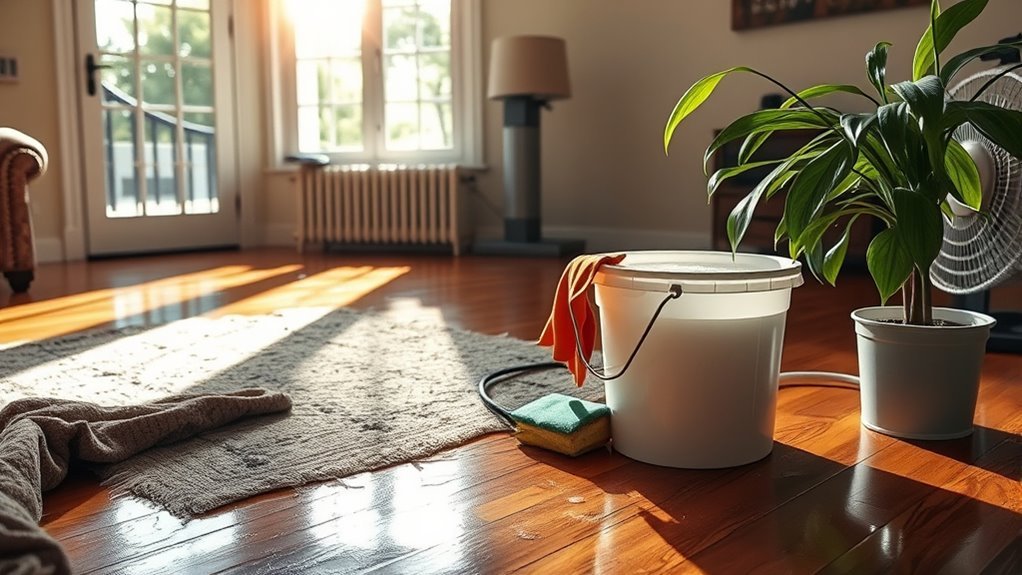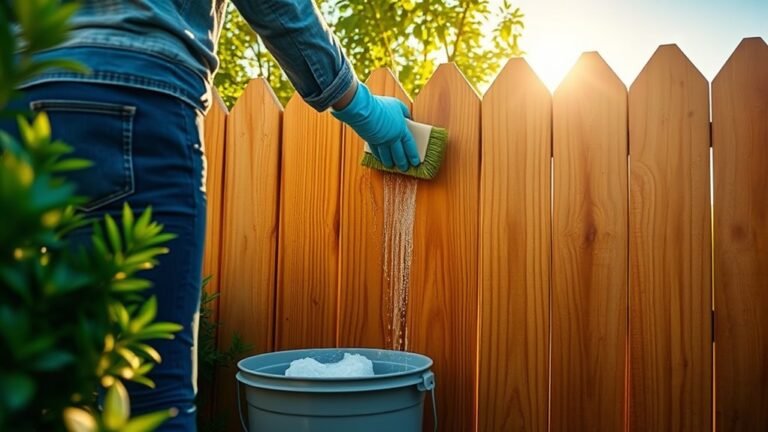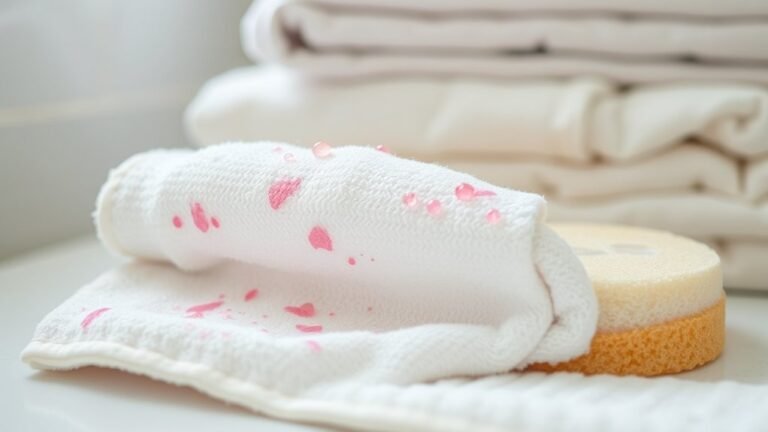So reinigen Sie ein Haus nach einer kleinen Überschwemmung
After a minor flood, first make sure the water has receded and check for safety hazards like structural damage or gas leaks. Wear gloves and boots, then remove standing water using pumps or wet vacuums. Open windows and use fans to dry everything thoroughly. Clean surfaces with disinfectants to prevent mold and salvage what you can. Inspect for mold signs and repair damaged materials. To avoid future issues, consider flood barriers and proper drainage. Keep going for detailed tips on recovery and prevention.
Assess the Damage and Ensure Safety
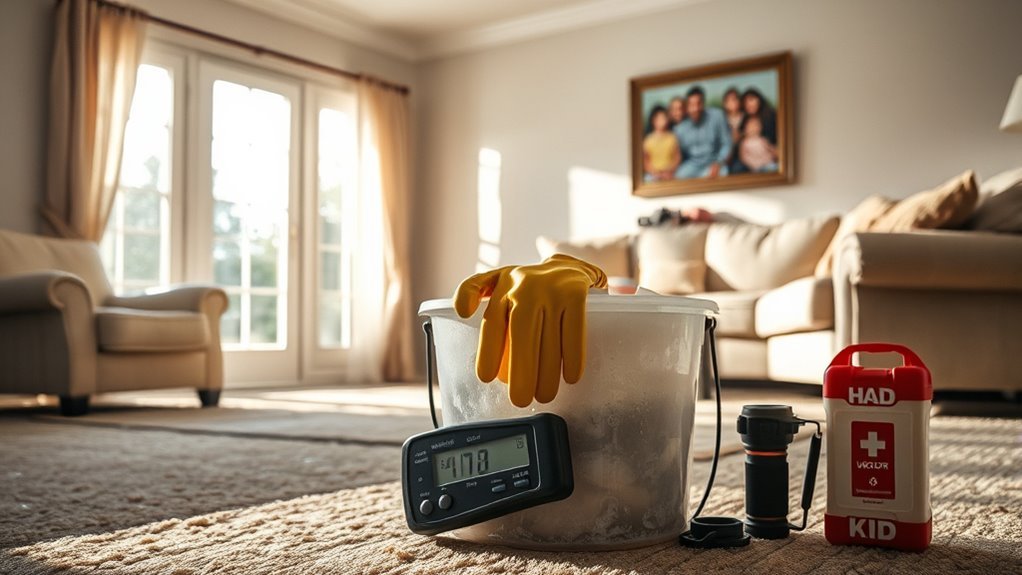
Before you begin cleaning, make sure the floodwaters have fully receded and the area is safe to enter. Your first priority is taking essential safety precautions—check for structural damage, exposed electrical wires, and gas leaks. Don’t rush in; your freedom depends on staying unharmed. Conduct a thorough damage evaluation, noting which walls, floors, and belongings have been affected. This helps you prioritize what needs immediate attention and what can wait. Wearing gloves and sturdy boots protects you from contaminants lurking in floodwater residues. By carefully evaluating damage and respecting safety precautions, you empower yourself to take control of the cleanup process without risking injury. Remember, freedom starts with safety—once you’re sure the space is secure, you can confidently move on to restoring your home.
Remove Standing Water Efficiently
To get your home dry quickly, you’ll want to remove standing water as efficiently as possible. Using pumps and wet vacuums can speed up this process considerably. The faster you act, the less damage you’ll prevent.
Use Pumps and Vacuums
Start by removing as much standing water as you can using pumps and wet/dry vacuums. A sump pump is perfect for quickly extracting large volumes of water, while a wet vacuum helps you reach smaller, tricky spots. These tools give you control and freedom to tackle the mess effectively and fast. Here’s a quick reference to help you choose and use them wisely:
| Tool | Best Use |
|---|---|
| Sump Pump | Large water volumes |
| Wet Vacuum | Small puddles, corners |
| Hose | Direct water away |
| Extension Cord | Power in hard-to-reach spots |
| Bucket | Manual removal, backup tool |
Using these guarantees you’re prepared to reclaim your space without delay or hassle.
Speed Up Water Removal
Although removing standing water can feel overwhelming, acting quickly will prevent further damage and speed up the drying process. You can use a combination of water removal techniques like wet/dry vacuums and mops to tackle the water efficiently. Don’t forget to open windows and doors to improve air circulation, which is essential for quick drying methods. If possible, set up fans and dehumidifiers to draw out moisture faster and reduce the risk of mold. Remember, the key is to start immediately and use every tool at your disposal to remove water thoroughly. By doing so, you regain control over your space and minimize the flood’s impact, giving you the freedom to restore your home with confidence and ease.
Dry Out the Affected Areas Thoroughly
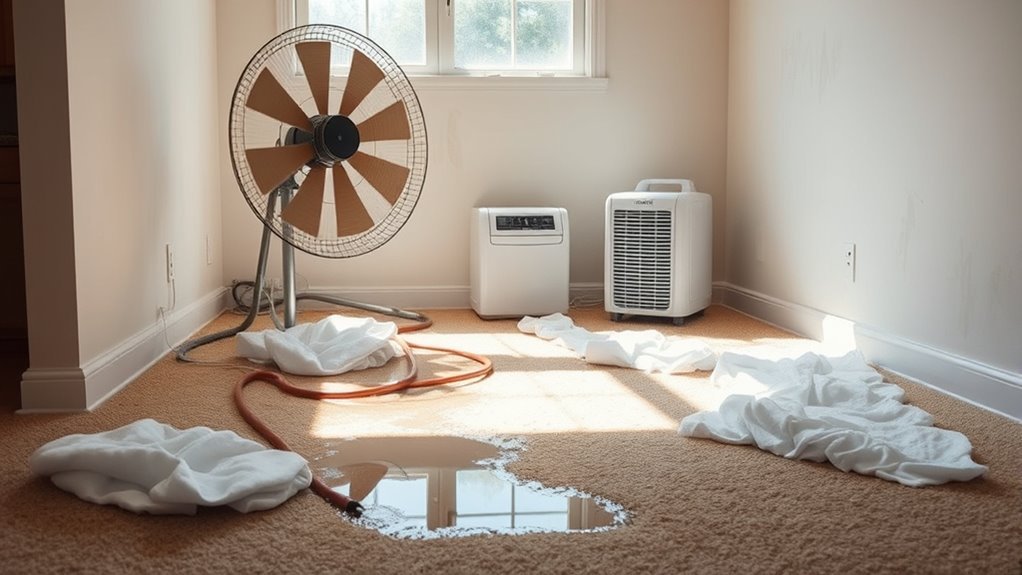
Before you move on to cleaning, make certain the affected areas are completely dry to prevent mold and mildew growth. You want to reclaim your space without lingering moisture causing trouble later. Focus on boosting air circulation and consider dehumidifier usage to speed up drying. Here’s how to get it done:
- Open windows and doors to create natural airflow.
- Use fans to circulate air in tight spots.
- Run a dehumidifier to pull moisture from the air.
- Remove wet carpets, furniture, and drywall if needed.
- Check hidden spaces like behind baseboards or under flooring for trapped dampness.
Taking these steps guarantees your home dries thoroughly, letting you move forward with cleaning and restoring your freedom from the flood’s aftermath.
Clean and Disinfect Surfaces Properly
Once your home is completely dry, you’ll want to clean and disinfect all surfaces to eliminate harmful bacteria and prevent mold growth. Choosing the right disinfecting solutions for various surface types guarantees effective cleaning without damage. Hard surfaces like tile or metal need stronger disinfectants, while wood or fabric require gentler options.
| Surface Type | Recommended Disinfecting Solution | Notes |
|---|---|---|
| Tile/Metal | Bleach solution or alcohol-based | Effective, quick drying |
| Wood | Mild detergent + vinegar | Avoid harsh chemicals |
| Fabric/Upholstery | Enzyme cleaner or detergent | Prevents odor, gentle on fibers |
Stick to guidelines, ventilate well, and wear gloves. This method keeps your space safe and fresh, restoring your home’s freedom.
Salvage and Restore Personal Belongings
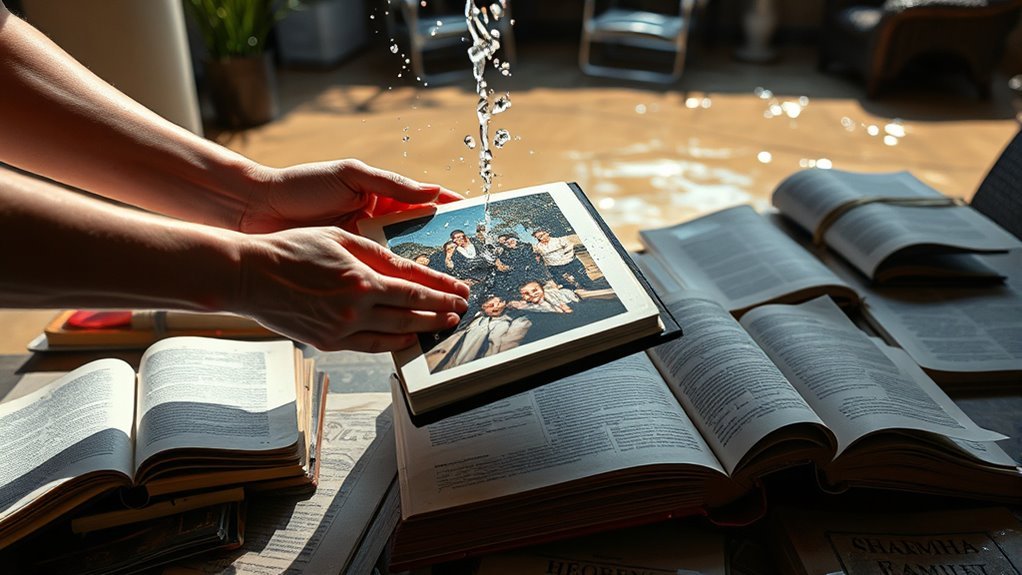
You’ll want to carefully assess the damage to your personal belongings before deciding what can be saved. Items that are wet should be cleaned promptly and dried thoroughly to prevent mold and further damage. Taking these steps quickly will help you restore your belongings as much as possible.
Assess Damage Thoroughly
Although it might feel overwhelming, carefully evaluating the damage is essential to deciding what can be salvaged or restored. When conducting your damage assessment, prioritize safety precautions like wearing gloves and sturdy shoes to protect yourself. Look closely at each item and area affected by the flood to determine the extent of harm. Focus on these key points:
- Check for water stains or warping on furniture
- Inspect electrical appliances for moisture damage
- Assess clothing and textiles for mold or contamination
- Examine books and important documents for water exposure
- Scan flooring and walls for structural integrity issues
Clean and Dry Items
Start by carefully cleaning and drying your salvageable belongings to prevent mold and further damage. For furniture care, wipe down wooden surfaces with a gentle cleaner and dry them promptly to avoid warping. Upholstered furniture needs special attention—use fabric cleaning solutions designed for water damage and guarantee thorough drying by placing items in a well-ventilated area or using fans. Remove cushions and dry them separately to prevent mildew. For fabric cleaning, wash curtains, rugs, and clothing according to their care labels, preferably with a disinfectant additive to eliminate bacteria. Avoid leaving damp items around, since moisture fuels mold growth. By promptly and properly cleaning and drying your belongings, you regain control over your space and keep your home fresh and safe after a minor flood.
Check for Mold Growth and Prevent It
How can you tell if mold has started to grow after a flood? You’ll want to inspect your home carefully because mold can spread quickly, threatening your freedom to enjoy a healthy space. Look for these signs:
- Musty or earthy odors lingering in rooms
- Visible discoloration or fuzzy patches on walls and ceilings
- Peeling or bubbling paint and wallpaper
- Allergic reactions like sneezing or coughing when inside
- Dampness or condensation on windows and surfaces
For effective mold prevention, focus on humidity control by using dehumidifiers and improving ventilation. Keeping your home dry is key to stopping mold before it takes hold. Don’t wait—act fast to keep your space safe and free from mold’s grasp.
Repair or Replace Damaged Materials
Once you’ve addressed potential mold issues, it’s time to assess the flood’s impact on your home’s materials. Different material types react differently to water damage, so you’ll want to carefully evaluate each area. Drywall and insulation often need replacement, while hardwood floors might be salvageable with proper drying and refinishing. Consider your repair options—sometimes patching up smaller damaged sections works, but extensive damage may call for full replacement to avoid future problems. Don’t hesitate to remove and replace soaked carpets or padding since they can harbor mold. Ultimately, your goal is to restore your home efficiently while maintaining a safe, comfortable space that lets you move forward freely without lingering flood damage issues.
Implement Preventative Measures for Future Floods
Although cleaning up after a minor flood is essential, taking steps to prevent future flooding is just as important. You want to protect your freedom from the stress and damage floods bring. Here’s how you can safeguard your home:
- Install flood barriers around vulnerable entry points.
- Regularly maintain and clear drainage systems to guarantee water flows away.
- Elevate electrical outlets and appliances above potential water levels.
- Seal cracks in your foundation and walls to stop water seepage.
- Landscape your yard to direct water away from your home.
Häufig gestellte Fragen
What Types of Insurance Cover Minor Flood Damage in Homes?
If you’re wondering about flood insurance, it’s key to know standard homeowners insurance usually doesn’t cover flood damage. You’ll need specific flood insurance, often available through the National Flood Insurance Program or private insurers. Coverage options vary, so you can choose plans that suit your freedom to protect your home without overpaying. Always check what’s included—some policies cover structural damage, while others might include belongings. Being informed helps you stay free from unexpected expenses.
Can Pets Stay Safely in the Home During Flood Cleanup?
Sure, letting your pets roam freely during flood cleanup sounds like a brilliant idea—if you want chaos and muddy paw prints everywhere. For pet safety, it’s actually smarter to keep them in a safe, dry spot away from the mess. Taking flood precautions means protecting them from contaminated water and hazardous materials. You want your furry friends free, but also safe, so giving them a cozy refuge during cleanup is the true freedom they deserve.
How Long Does It Typically Take to Fully Recover After a Flood?
Your flood recovery timeline can vary, but it typically takes weeks to months to fully bounce back. You’ll want to follow flood cleanup tips like drying out your space quickly, removing damaged items, and disinfecting surfaces. Staying proactive helps you regain control and freedom in your home sooner. Remember, every situation is unique, so pace yourself, and don’t hesitate to ask for help when you need it.
Are There Any Specific Tools Recommended for Flood Cleanup?
Oh sure, you’d probably love to just grab a mop and call it a day, right? But if you want real freedom from lingering dampness and mold, wet vacuums are your best friends—they suck up water efficiently, making cleanup faster. You’ll also want tools that help with mold prevention, like fans and dehumidifiers, so you’re not trapped dealing with mold later. Equip yourself right, and you’ll reclaim your space without chains.
What Are the Health Risks Associated With Minor Floodwater Exposure?
You’ve got to be careful because health hazards from minor floodwater exposure can sneak up on you. That water often carries bacteria and contaminants, creating a perfect environment for bacterial growth. If you don’t act quickly, you risk infections, skin irritations, or respiratory issues. Staying aware and protecting yourself lets you maintain your freedom to live safely and comfortably without letting these hidden dangers control your life.
